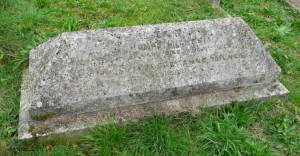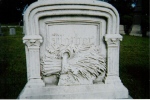
©Carole Tyrrell
I was on a summer stroll in early July of this year in Kensal Green Cemetery when I noticed this symbol. From where I was standing it resembled a mop head which had dried out and been left on top of a grave. I was planning to carry on stalking obliging butterflies but curiosity got the better of me and I made my way over to the monument. It was then that I realised that the supposed mop head was in fact a beautifully sculpted wheatsheaf.
‘Had the deceased been a master baker?’ was my first thought as it’s a traditional symbol associated with them or perhaps a pub owner as you do see a lot of pubs called The Wheatsheaf. The epitaphs on both side of the tomb were virtually unreadable. However, on one side I could make out ‘Sarah’ and on the other ‘Milnes’. But more of the Milnes later as this family has a strong connection to Kensal Green Cemetery
A sheaf is a tied bunch of grain stalks after they have been harvested by hand with scythes. However with the advent of agricultural mechanisation it is now a bygone image. No-one has ever known the origins of this staple crop and so it has been regarded by many cultures as a gift from God.
The wheatsheaf and resurrection
However, the wheatsheaf symbol has always had strong associations with the theme of resurrection.
This seemingly humble grain has played its part in many funeral cults and mourning rites throughout ancient cultures. For example, the ancient Greeks and Romans regarded it as life springing from death or immortality. Priests are reputed to have sprinkled wheat flour on their victim’s head prior to sacrificing them. Ceres and Demeter, the Greek and Roman goddesses of harvest and agriculture, often carried either a wheatsheaf or a harvester’s sickle. Ancient Egypt was seen as the breadbasket of the ancient Mediterranean due to the volume of crops that it produced and Osiris, god of the underworld, was strongly associated with wheat within the context of a representation of rebirth.
Wheat is also important to the Christian religion with the Eucharist bread which represents the body of Christ and his sacrifice and also in remembrance of the Last Supper. There is the famous biblical quotation from Luke 22:19:
‘and he took bread and gave thanks, and brake it, and gave unto them, saying, This is my body which is given for you: do this in remembrance of me’ King James Bible.
When wheat is harvested the ground is left to lie still during the winter and then re-sown in the spring to begin the cycle of life again. Here it represents renewal and renewal as the cycle of seasons has once more given grain for bread. There is also the association with the harvesting of years in that Death and his scythe prepare to reap at the end of life.
So there has always been an association with the wheatsheaf of resurrection and remembrance. This is where it is at its most powerful as a funerary symbol. However, Douglas Keister has also suggested that a wheatsheaf on a tombstone can indicate someone who
‘lived a long and fruitful life of more than seventy years and one that was harvested by the Reaper when it was time’
The wheatsheaf and the Victorian cult of mourning

I found it on Pinterest and could not find the source of the image.
According to the art of mourning website, the wheatsheaf was also a very popular motif in Victorian mourning jewellery. In fact they have suggested that it could be seen as a memento mori in that it denotes life cut and renewal or resurrection of the soul. Its heyday was during 1820-1860 and it also survived into early 20th century mourning jewellery just as it was going out of fashion. The wheatsheaf was often found in mourning wreaths, brooches, lockets and rings and was an effective emblem when working with hair to create these pieces.
There is also a stained glass window featuring a wheatsheaf at St Michael & All Angels in Eaton Bishop, Herefordshire but this may be a Victorian addition by Kempe after restoration.
But who lies under the Kensal Green wheatsheaf?

©Chris Bell – a family descendant
This grave contains 2 women who were, respectively, the first and second wives of the Victorian sculptor Thomas Milnes. He is buried with his third and final wife elsewhere within Kensal Green cemetery under a far plainer stone. He certainly lived a long life – his dates are 21 December 1810 – 6 May 1888 but there’s no wheatsheaf on top of him. Milnes completed a number of funerary monuments which can be seen in churches in Gloucestershire, Cumbria and Suffolk and also statues which still stand in Norwich and Woolwich. Milnes exhibited statues and busts at the Royal Academy after entering its schools on 21 April 1841. He also designed another monument in Kensal Green, the horse and child on top of Alfred Cooke, which, although damaged, is still in place.
However he wasn’t destined to became a major British sculptor despite, in 1858, being invited to design and model the four lions for the base of Nelson’s column. It would have been the commission of a lifetime but his designs were deemed ‘unsuitable’ and the commission went to Sir Edwin Landseer’s monumental symbols of Empire instead. However, Milnes lions which are, in my opinion, more lively and playful than Landseer’s can be seen in Saltaire, near Bradford. After that he seems to have sunk in obscurity.
The ‘Sarah’ that is still legible on one side was Milnes’ first wife: Sarah Betsey Harrad. They married in London on 19 May 1836. Sarah died on 1 April 1867 of ‘apoplexy’ which is now known as a stroke or cerebral haemorrhage. Frances Eidsforth became his second wife on 16 July 1867 at St Georges, Bloomsbury and she died on 16 July 1875. She is buried with Sarah.
Milnes married his third and final wife, Jessie Anne Fletcher, on 1 June 1876 but there were no children from any of his marriages

©Carole Tyrrell
Little seems to be known about either Sarah or Frances and it’s a real shame that their epitaphs, presumably on either side of the monument are now illegible. However I would assume that the wheatsheaf placed on top of them is a symbol or resurrection and a hope that they would all meet again in eternity.
The wheatsheaf is remarkably well carved and has outlasted the epitaphs. It has been presumed that it is by Milnes himself but no definite proof has been found to be able to attribute it to him with certainty.
There is another smaller wheatsheaf in Kensal Green which is on the Samuel Horsley memorial.
These two examples are from Oak Grove Cemetery, Fall River, Massachusetts, USA – I don’t have any further details on them unfortunately.
©Text and photos Carole Tyrrell otherwise stated
I am indebted to Henry Vivian-Neal from the Friends of Kensal Green Cemetery for the biographical details on Thomas Milnes.
References:
Douglas Keister, Stories in Stone: A field guide to cemetery symbolism and iconography, Gibbs Smith 2004
https://friendsofoakgrovecemetery.org/category/victorian-funeral-symbolism/page/2/
http://artofmourning.com/2011/02/27/symbolism-sunday-wheat/
http://www.bbc.co.uk/london/content/articles/2005/05/10/victorian_memorial_symbols_feature.shtml
http://www.everlifememorials.com/v/headstones/cemetery-symbolism.htm
https://friendsofoakgrovecemetery.org/category/victorian-funeral-symbolism/page/2/
https://stoneletters.com/blog/gravestone-symbols
http://www.symbols.com/symbol/wheat
http://www.martin-nicholson.info/cemetery/cemeteryeatonb.htm
https://breadcakesandale.wordpress.com/2015/09/23/harvest-festival-wheat-sheaf-loaf/
http://sculpture.gla.ac.uk/view/person.php?id=msib7_1206548550
http://biblehub.com/luke/22-19.htm
http://www.victorianweb.org/sculpture/milnes/chron2.html











